what is adobe after effects cs6 used for

This Learn by Video course offers in-depth training on the interface, workflow, and features of Adobe After Effects CS6. If you subscribe to my newsletter you can get 20% off this course with a discount code. The contents of this course include:
Introducing After Effects CS6
In this chapter you'll get an overview of how After Effects works, what it does, and what the main controls are.
Interface Tour
Before you start following along with the instructions in this training, it will help to learn what the controls are called and where things are located. You'll learn about the basic controls and the most commonly used panels in this chapter.
Creating Compositions and Layers
In After Effects we work in projects. Every project contains compositions, each of which is the framework of a movie; layers are assembled within the framework of these compositions. In this chapter you'll learn how to create compositions and bring layers into them from the Project panel. You'll also learn how to create layers from scratch.
Importing Footage
In this chapter you'll learn how to bring various types of files into After Effects. You'll also see how to make sure After Effects interprets these files correctly and how to manage them once you get them in.
Interpreting and Managing Footage
Sometimes you need to tell After Effects how to use source files. This chapter shows you how to set various parameters for how files are interpreted and used.
Animation Basics
The most important aspect of learning to fully understand After Effects is getting to grips with how After Effects handles animation. Once you have mastered the topics covered in this chapter, you can really do anything in this powerful application.
Fine-Tuning Animation
This chapter will take your animation skills further by showing you how to understand timing. You'll learn how to work in the Layer panel and the Graph Editor for more precise control over layers and animation.
Animating Text Layers
Text layers can be animated in a variety of different ways to create exciting and compelling motion graphics. In this chapter you'll learn about the properties and methods used to control these layers. Text layer properties use a slightly different animation system than standard layer properties, so we'll also discuss the idiosyncrasies involved in animating these wonderfully flexible design elements.
Fun with Shape Layers
Shape layers are pretty unique but can be confusing to new users. This chapter will help demystify shape layers and give you the confidence to push them in all sorts of creative directions.
Basic Compositing
Compositing is about stacking layers on top of one another and making parts of each layer show through others in specific ways. You'll learn about many of the ways to composite layers together in this chapter.
Effects
After Effects provides you with scores of effects that you can apply to your layers, allowing you to create virtually any look or style you like. Imagine being able to animate all of these over time and you get a real sense of the creative flexibility that After Effects can offer you. This chapter tells you everything you need to know to create amazing effects.
Time
A movie is a series of images that plays over time, and After Effects provides many powerful controls for controlling exactly how this happens. This chapter will teach you about tools like frame blending, slow motion, freeze-frame, and more.
Grouping and Linking
There are times when it makes sense to group layers together into a single item, either to simplify complicated comps or to make editing, moving, or applying effects a whole lot easier. In this chapter we'll look at several methods for grouping layers together.
Introduction to 3D
After Effects allows you to transform and animate your layers within a 3D environment. This adds some complexity to your compositions. After Effects CS6 also lets you work in ray-traced 3D, where you can extrude and bevel shapes and text and even bend video layers. In this chapter you'll see how After Effects deals with mixing 2D and 3D in the same composition.
Memory and Performance
Every person, project, and computer system is different. In this chapter you'll learn how to configure After Effects to match your needs, the capabilities of your computer system, and the needs of your projects.
Render Order and Collapsing Transformations
Layers and their components are processed in a specific order. In this chapter you'll learn about that order and how to use special features to control it
Output Options
When you're finished with your project, you need to get your data out of After Effects, usually as a finished movie. In this chapter, you'll learn the basics of rendering and exporting movies.
Project Explorations and Recap
This chapter contains some examples of animations created in After Effects along with explanations of how they were made. You'll also get some tips on integrating After Effects with Cinema 4D, as well as some final thoughts on the course and suggestions for further learning.
The lessons are wrapped in a feature-rich interface that lets you jump to any topic and bookmark individual sections for later review. Full-Screen mode provides a hi-def, immersive experience, and Watch-and-Work mode shrinks the video into a small window so you can play the videos alongside your application. Also included are exercise files that give you an easy way to try out the techniques you learn and a 48-page guide containing supplemental material.
what is adobe after effects cs6 used for
Source: https://angietaylor.co.uk/adobe-after-effects-cs6-learn-by-video/
Posted by: lowewincert.blogspot.com

0 Response to "what is adobe after effects cs6 used for"
Post a Comment